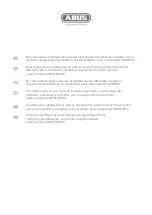
Safety, Technical Description, and Accuracy
10-14
ACUSON Cypress™ Operator’s Manual
U.S. Food and Drug Administration Medical Alert
The text of this medical alert is reproduced below.
Text of March 29, 1991 US FDA Medical Alert:
Allergic Reactions to Latex-
Containing Medical Devices
:
Because of reports of severe allergic reactions to medical devices con-
taining latex (natural rubber),
FDA
is advising health professionals to
identify their latex-sensitive patients and be prepared to treat allergic
reactions promptly. Patient reactions to latex have ranged from contact
urticaria to systemic anaphylaxis. Latex is a component of many medi-
cal devices, including surgical and examination gloves, catheters, intu-
bation tubes, anesthesia masks, and dental dams.
Reports to
FDA
of allergic reactions to latex containing medical devices
have increased lately. One brand of latex cuffed enema tips was
recently recalled after several patients died as a result of anaphylac-
toid reactions during barium enema procedures. More reports of latex
sensitivity have also been found in the medical literature. Repeated
exposure to latex both in medical devices and in other consumer prod-
ucts may be part of the reason that the prevalence of latex sensitivity
appears to be increasing. For example, it has been reported that 6% to
7% of surgical personnel and 18% to 40% of spina bifida patients are
latex sensitive.
Proteins in the latex itself appear to be the primary source of allergic
reactions. Although it is not now known how much protein is likely to
cause severe reactions,
FDA
is working with manufacturers of latex
containing medical devices to make protein levels in their products as
low as possible.
FDA
’s recommendations to health professionals in regard to this prob-
lem are:
—When taking general histories of patients, include questions about
latex sensitivity. For surgical and radiology patients, spina bifida
patients, and healthcare workers, this recommendation is especially
important. Questions about itching, rash or wheezing after wearing
latex gloves or inflating a toy balloon may be useful. Patients with pos-
itive histories should have their charts flagged.
— If latex sensitivity is suspected, consider using devices made with
alternative materials, such as plastic. For example, a health profes-
sional could wear a non-latex glove over the latex glove if the patient is
sensitive. If both the health professional and the patient are sensitive,
















































